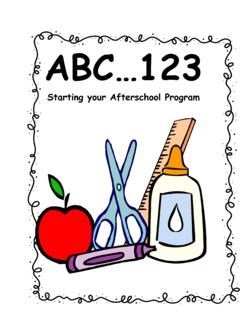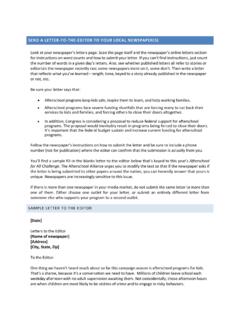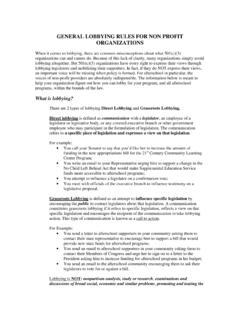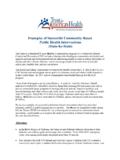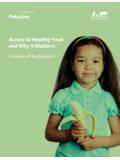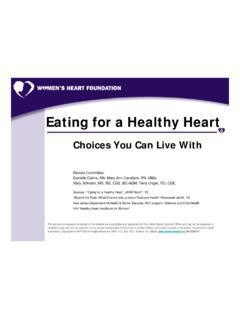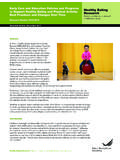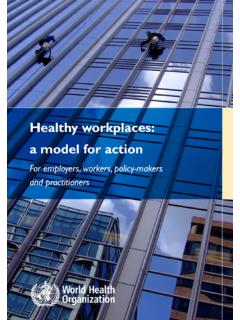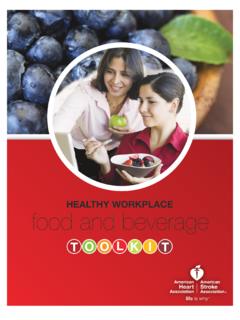Transcription of America After 3PM Special Report: Afterschool in ...
1 August 2016 America After 3PM Special Report: Afterschool in communities of concentrated PovertyAmerica After 3PM: Special Report2 Table of ContentsAcknowledgementsData from this Special report are based on the 2014 America After 3PM survey results, which relied on critical support from the Charles Stewart Mott Foundation, The Wallace Foundation, the Robert Wood Johnson Foundation, the Ford Foundation and the Noyce Foundation, with further support from the Heinz Endowments, The Robert Bowne Foundation and the Samueli Introduction6 Executive Summary12 The demand for Afterschool and summer learning programs in communities of concentrated poverty is high14 Barriers to participation in Afterschool programs18 Afterschool programs are creating opportunities for all students20 The value of aftershool programs to parents living in communities of concentrated poverty23 Recommendations26 EndnotesAfterschool in communities of concentrated Poverty3 IntroductionDespite our increasingly mobile and interconnected world, where more than 90 percent of households have a cari and close to 9 in 10 adults have access to the Internet.
2 Ii it is a persistent reality that locations and their demographics have a significant impact on people s lives. For children and families, where they call home impacts a number of critical factors, including the number of safe spaces available for playing outside, access to grocery stores with fresh produce, quality of education, and access to Afterschool and summer learning opportunities. Affluent communities offer a host of positive influences and benefits for their residents. But in communities of concentrated poverty , or areas with a high percentage of families living below the poverty level, research has found the opposite. Families living in these high- poverty areas are more likely to be without ready access to supermarkets and grocery stores that sell affordable and healthy foods,iii are less likely to have health insurance, and may have limited job opportunities in their Children living in communities of concentrated poverty are more likely to attend schools where the dropout rate is high and test scores are low, and to live in neighborhoods with higher crime This is especially troubling in light of a report from the Census Bureau that found that the number of people living in communities of concentrated poverty increased by more than 50 percent between 2000 and 2010 from million people to million people.
3 More than 20 million of those living in poverty areas are children and youth under the age of ,vii The likelihood of living in an area of concentrated poverty is even higher among African-Americans and Hispanics. African-Americans are times as likely as whites to live in a community of concentrated poverty (50 percent versus 20 percent) and Hispanics are approximately two times as likely (44 percent versus 20 percent).viii Among children living in communities of concentrated poverty , again, African-American and Hispanic children were much more likely to live in these communities . African-American and Hispanic children were at least two times as likely as white children to live in communities of concentrated poverty ; 45 percent of African-American, 35 percent of Hispanic and 12 percent of white children are in families living in communities of concentrated America After 3PM: Special Report4 More than 20 million children and youth under the age of 18 live in communities of concentrated poverty .
4 What are communities of concentrated poverty ? communities of concentrated poverty are neighborhoods, or groupings of neighborhoods, in a community where there is a high concentration of families that live below the federal poverty line. In 2016, the federal poverty guideline for a family of four was $24,300. Scholars have included areas with at least 20 percent of families living below the poverty line up to at least 40 percent of families living below the poverty line as a community of concentrated poverty . For the purposes of America After 3PM, survey respondents living in communities of concentrated poverty are those that meet the following criteria: Live in a zip code that falls within a census tract that the Census Bureau has designated as a community of concentrated poverty , and Live in a zip code that has poverty rate of 30 percent or of Health & Human Services.
5 (2016). Computations for the 2016 poverty Guidelines. Retrieved from ; Bishaw, A. (2014). Changes in Areas with concentrated poverty : 2000-2010. American Community Survey Reports. United States Census Bureau. Opportunity Nation is a nonprofit organization working toward making sure all children are afforded equal opportunities to succeed in effects of living in communities of concentrated poverty are far-reaching and extend beyond issues of access and a person s present day situation. Health issues including asthma, diabetes and depression are higher in communities of concentrated poverty , and children living in these communities face higher levels of stress and behavior Research has linked early brain development to household income, finding that the brain development of children living in poverty lagged behind that of their higher-income peers.
6 The same study also found that children living in poverty scored lower in academic achievement tests when compared to children living above the poverty Negative long-term consequences have also been documented; the likelihood of a child s future success also decreases when growing up in a community of concentrated For example, Opportunity Nation1 found that the opportunities necessary for economic mobility are tied directly to where one lives. (See the box A tale of two counties for more details.)Taking into account both the documented increase in communities of concentrated povertyxiii and the diverse struggles and barriers facing families living in these communities , quality Afterschool programs, which include before school, Afterschool and summer learning programs, are critical systems of support that can help bring back into balance opportunity at all levels.
7 Afterschool programs provide their students a number of supports, including a safe environment, academically enriching activities, mentors who care about them and who they can look up to, healthy snacks and meals, and opportunities for physical activity. Many programs also provide parents additional opportunities to become more involved in their child s education, offer supportive services for entire families, and give parents peace of mind about their child s safety when they are at work or looking for has found that when children from low-income families take part in quality Afterschool programs, they see positive gains. Consistent participation in high-quality Afterschool programs has been shown to help students improve their work habits and demonstrate higher levels of persistence, and helps to close the achievement gap that exists between children from low-income families and their more affluent It was also found that the positive impact of Afterschool programs on children matches that of early childhood programs from academics to social and behavioral Given the promising role Afterschool programs can play in addressing the inequities faced by families living in communities of concentrated poverty , and with the rise in the number of people living in communities of concentrated poverty .
8 This Special America After 3PM report examines the Afterschool program experience of children and families living in communities of concentrated poverty in regard to participation, access, activities and satisfaction. Afterschool in communities of concentrated Poverty5A tale of two countiesBelow are two neighboring counties in Michigan. Despite the proximity to one another, a child growing up in Wayne County will attend schools that have a lower percentage of students who graduate on time and will live in a community with a higher unemployment rate and a higher percentage of disconnected youth (youth ages 16 to 24 who are neither in school nor employed).Wayne County, Michigan (C-)Michigan s Wayne County received an Opportunity Index grade of C.
9 Here, one quarter of the population lives below the poverty line; the unemployment rate is 6 percent, higher than the national rate of 5 percent; the percentage of students who graduate on-time is 74 percent versus the national average of 81 percent; and less than 3 in 10 adults in the county have earned an Associate Degree or higher, nearly 10 percentage points lower than the national average of 38 percent. The percentage of disconnected youth in the area is also higher than that of the national average at 21 percent, compared to 14 percent nationally. Washtenaw, Michigan (B+)Washtenaw County, where the percentage of the population living below the poverty line is 15 percent, received a B+ on the Opportunity Index. Here, the unemployment rate is lower than the national rate and both the percentage of on-time high school graduation and the percentage of adults with an Associate Degree or higher are above the national average.
10 Washtenaw County s percentage of disconnected youth is less than the national average and 15 percentage points lower than Wayne County. Opportunity Nation. Opportunity Index. Retrieved on July 1, 2016 from # and # rate 74 %On-time graduates 25%Population below the poverty line 29%Adults with an Associate Degree or higher 21%Disconnected youth3%Unemployment rate 83%On-time graduates15%Population below the poverty line 58%Adults with an Associate Degree or higher 6%Disconnected youth America After 3PM: Special Report6 Research has documented the positive impacts associated with participation in Afterschool programs, including academics and social and emotional outcomes,xvi and many news stories have raised awareness about the essential supports and services Afterschool programs provide to students and their Afterschool programs have come to be recognized as critical partners in helping to ensure that all children are afforded the opportunities that will help them thrive and meet their full potential.

